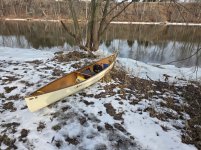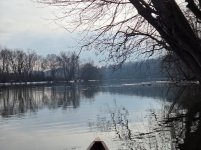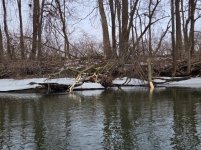I had just gotten a new boat, and wanted to “test” it. You know, you have to make sure it floats.  . It was October and two friends and I went to a nearby big pond. I had on my wet suit. We were staying near shore. At one point, I was testing something, and went over. I bobbed up, and told one of my friends that I would swim to shore, could he just push the boat to shore for me. Apparently, I said, “wuuuwh wuuuwh wuuuwu wuuush,” and just bobbed in the water. He, a lifeguard/ ACA kayak instructor/dive master/paramedic looked at me, doing nothing, and asked, “Do I have to rescue you?” The other friend, with similar credentials, sat in her boat with a similar look on her face. Something woke me up, and I swam the short distance to shore. I have remembered it since, though. I was wearing my wet suit, it wasn’t super cold, I was near shore, and I did nothing. Cold water is scary stuff.
. It was October and two friends and I went to a nearby big pond. I had on my wet suit. We were staying near shore. At one point, I was testing something, and went over. I bobbed up, and told one of my friends that I would swim to shore, could he just push the boat to shore for me. Apparently, I said, “wuuuwh wuuuwh wuuuwu wuuush,” and just bobbed in the water. He, a lifeguard/ ACA kayak instructor/dive master/paramedic looked at me, doing nothing, and asked, “Do I have to rescue you?” The other friend, with similar credentials, sat in her boat with a similar look on her face. Something woke me up, and I swam the short distance to shore. I have remembered it since, though. I was wearing my wet suit, it wasn’t super cold, I was near shore, and I did nothing. Cold water is scary stuff.
-
Happy Publication of Dickens' "A Christmas Carol" (1843)! 😠👻🩼🎄
You are using an out of date browser. It may not display this or other websites correctly.
You should upgrade or use an alternative browser.
You should upgrade or use an alternative browser.
The Scary Truth About Surviving Capsizing In Cold Water
- Thread starter Glenn MacGrady
- Start date
Most canoe races these days require wearing of a PFD at all times during the race. Their insurance policy requires it. Many states, mine included, require everyone in small boats to wear one from 1 November to 1 May, and 100% of the year for youth under age 12.
During the Adirondack 90-mile canoe race, for the first 30+ years it was running (until NFCT took possession of the race), PFD wear was optional, unless weather conditions and the race director or DEC so mandated it. Theory was, with up to 250 boats in the race available to give aid, and with numerous safety and end sweep boats posted and observing each boat in multiple places throughout the course, the danger was minimal with a PFD in the boat but not actually being worn.
During the Yukon River races, 100% wear of a PFD is always mandatory while paddling in that 40F degree glacial melt water. in addition, once we enter the wide 35-mile-long Lake Laberge, we are required to remain within 200 meters of the lake's eastern shoreline. I remember one time when in a large voyageur canoe at (or even beyond) our 200-meter limit we were caught in a heavy following wind causing huge rolling white capped waves when I was in the bow taking splashing wash over the bow on to me, soaking me in that chilly spray. We kept on our straight course line downwind because any turn altering to the side could have been even more dangerous in that surf. The entire crew was concerned about our survival chances of swimming the distance to the shore if we needed to. We could see a number of other racers waiting it out on the distant shore. Eventually the shore came to us as we skirted in and out of relatively protected coves between jutting rocky outcroppings.
Much further downriver, at the Five Finger Rapids, a relateively short run often with 3+ foot high standing waves, it was common for a few boats to capsize and either self-rescue on an island just below the rapids runout area, or to be rescued by a safety boat stationed there. But that safety boat is only there for support during the relatively short (440 mile) Yukon River Quest. During the totally unsupported 1000-mile race, there are no safety boats posted anywhere on the river race course.
During the Adirondack 90-mile canoe race, for the first 30+ years it was running (until NFCT took possession of the race), PFD wear was optional, unless weather conditions and the race director or DEC so mandated it. Theory was, with up to 250 boats in the race available to give aid, and with numerous safety and end sweep boats posted and observing each boat in multiple places throughout the course, the danger was minimal with a PFD in the boat but not actually being worn.
During the Yukon River races, 100% wear of a PFD is always mandatory while paddling in that 40F degree glacial melt water. in addition, once we enter the wide 35-mile-long Lake Laberge, we are required to remain within 200 meters of the lake's eastern shoreline. I remember one time when in a large voyageur canoe at (or even beyond) our 200-meter limit we were caught in a heavy following wind causing huge rolling white capped waves when I was in the bow taking splashing wash over the bow on to me, soaking me in that chilly spray. We kept on our straight course line downwind because any turn altering to the side could have been even more dangerous in that surf. The entire crew was concerned about our survival chances of swimming the distance to the shore if we needed to. We could see a number of other racers waiting it out on the distant shore. Eventually the shore came to us as we skirted in and out of relatively protected coves between jutting rocky outcroppings.
Much further downriver, at the Five Finger Rapids, a relateively short run often with 3+ foot high standing waves, it was common for a few boats to capsize and either self-rescue on an island just below the rapids runout area, or to be rescued by a safety boat stationed there. But that safety boat is only there for support during the relatively short (440 mile) Yukon River Quest. During the totally unsupported 1000-mile race, there are no safety boats posted anywhere on the river race course.
Last edited:
I've been taught that you must always dress for immersion.
Simply assuming that you're unlikely to capsize can be extremely dangerous. The annoying part is that there are many weather conditions when dressing for immersion means that you'll be uncomfortable during the entirety of the paddling activity (paddling in a wetsuit is no treat!) so its very tempting to underdress and assume the best outcomes.
The good news is that you can solve for most conditions with the right gear. I have a 7mm hooded wetsuit that allows me to surf reasonably comfortably in the wintertime when water temps are in the 30s. There's no getting away from the ice cream headaches during a duck dive but otherwise I stay warm, even though I'm a lousy surfer...
A nice dry suit changes everything for the paddler.
Simply assuming that you're unlikely to capsize can be extremely dangerous. The annoying part is that there are many weather conditions when dressing for immersion means that you'll be uncomfortable during the entirety of the paddling activity (paddling in a wetsuit is no treat!) so its very tempting to underdress and assume the best outcomes.
The good news is that you can solve for most conditions with the right gear. I have a 7mm hooded wetsuit that allows me to surf reasonably comfortably in the wintertime when water temps are in the 30s. There's no getting away from the ice cream headaches during a duck dive but otherwise I stay warm, even though I'm a lousy surfer...
A nice dry suit changes everything for the paddler.
Last edited:
A nice dry suit changes everything for the paddler.

There is some truth in that.
>> A nice dry suit changes everything for the paddler. <<
If it's too cold - just put on another layer, if it's too warm - just take a layer off.
With a drysuit and the appropriate layers, you are always perfectly dressed and always dry and cozy.
And, you still look good!
Last edited:
- Joined
- Jun 22, 2017
- Messages
- 1,235
- Reaction score
- 3,026
My take is that you are likely to be in an emergency situation if you end up in cold water regardless of how you are dressed. In Pringles example being with highly capable partners is a huge benefit in any emergency situation. I agree that a drysuit adds a lot of protection. As a solo paddler if I end up in the water my hands will get cold and stop working normally almost instantly and handling a wet boat and gear will make it worse. If I'm in even s slightly remote area you're just going to get colder and colder if you don't have dry towels and dry gloves and hat and a way (or 2) of heating yourself back up. Sometimes I wear some neoprene under my drysuit and I still carry a dry bag with extra stuff and I typically stay near populated areas when alone...and there are still plenty of scenarios where real trouble could happen.
Water temp 34 last week and while it looks like there is very little shore ice there are very very few places where you can get in or out of the river because there's 6-10 feet of shore ice everywhere so good luck climbing uphill on ice (and salvaging your gear) if you end up in the water.
Water temp 34 last week and while it looks like there is very little shore ice there are very very few places where you can get in or out of the river because there's 6-10 feet of shore ice everywhere so good luck climbing uphill on ice (and salvaging your gear) if you end up in the water.
Attachments
Last edited:
Dress for immersion. Wear PFD and practice rescues.
I have one incident about dogs and cold water. One winter day I had a knock on my door. There was no snow on the ground, but it was relatively cold weather. A neighbor explained that my first Border Collie was stuck in the irrigation ditch and could not get out. I pulled her out of the water, but she could not walk because of the cold water. I literally put her in a wheel barrow to get her to the house, and built a fire in the stove. She perked up in about half an hour.
I have one incident about dogs and cold water. One winter day I had a knock on my door. There was no snow on the ground, but it was relatively cold weather. A neighbor explained that my first Border Collie was stuck in the irrigation ditch and could not get out. I pulled her out of the water, but she could not walk because of the cold water. I literally put her in a wheel barrow to get her to the house, and built a fire in the stove. She perked up in about half an hour.



